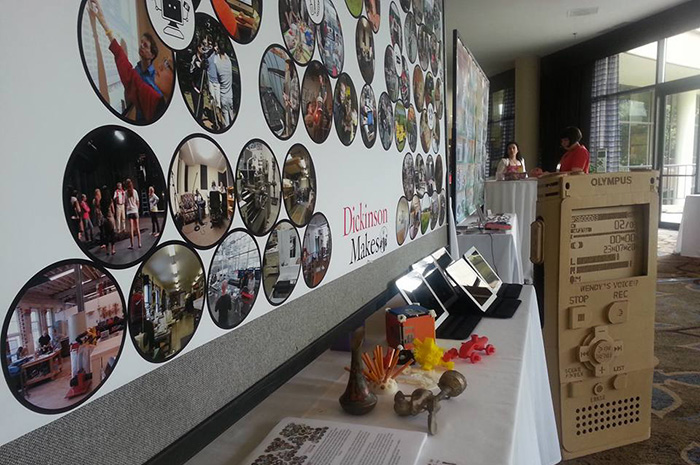Building STEAM

Programs earn awards at international conference
by MaryAlice Bitts-Jackson
Evolving technologies promise new ways to problem-solve, connect and engage in and out of the classroom, but with new products and programs constantly on the horizon, it can be tough for educators to keep pace. Events like the Idea Lab help by bringing tech professionals and educators together to discuss how they use technology in and out of the classroom. And at this year’s conference, held June 11, three Dickinson administrators were honored for their work on that front.
Reports from the field
The Idea Lab is a poster-presentation showcase that's part of a conference headed by the New Media Consortium (NMC), an organization founded in 1993 by a band of hardware and software designers and publishers that provides resources and information for education-technology movers and shakers in more than 200 colleges, universities and museums around the world. Partnering organizations include the U.S. Agency for International Development (USAID), UNESCO, the Organisation for Economic Co-Operation and Development, World Bank, United Nations University, the Education World Forum, Apple and HP’s Office of Global and Social Innovation.
As in years past, the organization's 2015 Idea Lab showcased some of the most exciting innovations in educational technology, with presentations by representatives from Yale, Georgetown, Case Western Reserve and New York universities, Dartmouth College, the Corning Museum of Glass, California State, University of Utah, TAFE Queensland and Rochester Institute of Technology, among other leading institutions. Of the 30 projects presented, 11 earned top honors, including a newly minted program developed by Multimedia Specialists Brenda Landis and Andy Petrus and a second-phase gaming-technology project led by Language Technology Specialist Todd Bryant.
Making room for making
Landis and Petrus earned judges’ choice and people’s choice awards for Dickinson Makes, an initiative launched last summer that supports collaborative projects by centralizing information about related campus resources, projects and events.
“It falls into the STEAM concept,” says Landis, referring to project-based programming aimed at building skills in science, technology, engineering, the arts and mathematics. “The goal is to remove the fear of not knowing how to do something and energize participants to try something fun and new.”
Users tap an online hub where students, faculty and staff can connect with like-minded people and groups, reserve campus spaces for meetings and learn about related coursework. Because Dickinson Makes projects are open to all across campus with a passion for making, they can help strengthen a sense of community.
And with its pilot year in the rearview, plans are in the works to add fall Dickinson Makes workshops and talks to the mix. Open to all students, the proposed sessions include workshops on how to build a tiny robot or make an electronic card that lights up when opened, and a "destroy-a-toy" event, inviting participants to take apart an electronic device and see how it works.
In the game
Bryant earned judges’ choice honors for his Modding Games program, which allows students and faculty members to modify the Civilization V video game to help teach and learn lessons in political science, international relations and history.
In his Idea Lab presentation, Bryant outlined his recent work with Shayna Solomon ’16 (political science, Judaic studies) and Edwin Padilla ’16 (computer science, music), who created a historical simulation of the colonization of Africa for use in a course taught by Associate Professor of Political Science and International Studies Edward Webb. It is the second “mod” set that Bryant has created for Webb, after adapting gaming technologies to help teach students about the 15th-century Americas, along with Padilla and student-researcher Patrick Schlee ’15 (history).
As Bryant notes, while Webb and his students enjoy the chance to use video games to learn complex historical material, the student researchers and programmers gain deep educational and professional experiences. After learning the variables of the Civilization game, Solomon and Schlee used primary and secondary sources to dig deep into historical events and then used software to design intricate maps and a database of real and possible variables and outcomes. Padilla, meanwhile, learned the database structure underlying the game and wrote database queries; he also used two programming languages to introduce new logical elements to the scenarios.
Bryant says he appreciated the chance to connect with fellow technologists at the Idea Lab and learn from their successes, and he hopes that colleagues at peer institutions will adapt his model for use in history and political-science lessons.
And while educators shared ideas, the Idea Lab also helped bring Dickinson's trailblazing efforts to light within the greater educational-technology community, adds Landis, who has attended NMC conferences since 2007 and looks forward to connecting with colleagues who expressed interest in her ongoing work. “People were especially interested in learning how we went about getting the right people, and we have already heard from a few people who saw the presentation and now are connecting with us to get more guidance,” she reports.
Learn more
- “Learning by Making”
- “Beyond the Blackboard”
- “Two New Historical Simulations” (Digital Humanities blog)
- Teaching With Technology
- Latest News
Published July 9, 2015